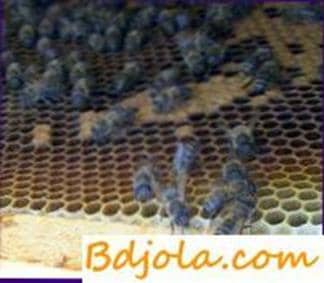
Melanosis is an infectious disease of the uterus, accompanied by the cessation of egg laying, the formation of a fecal plug and the blackening of the ovaries.
The causative agent of the disease – Melanosella mors apis – refers to imperfect yeast-like fungi, the order of hyphomycetes, the family of demagogic.
The causative agent can form a mycelium consisting of hyphae, and exist as separate yeast-like cells. Young hyphae lighter (from yellow to yellow-brown), darken with age and become black. In old cultures, thick-walled dark-colored chlamydospores often form.
When germinating them, depending on the nutrient medium, either sprouts may be formed that give rise to new hyphae, or yeast-like cells may arise. At first they are light, then darken: their dimensions are 1.5-5.2X3.1-14.7 microns. Chlamydospores larger – 10X13 microns and, as a rule, unicellular, less often with 1 or 2 septa. Hyphae in the diameter range from 1.5 to 6 microns.

Experimental infection of bees and queens during feeding does not cause illness. When the pathogen is introduced into the body cavity of the bee, the musculature, intestine, and glands are affected.
The development of the disease contributes to the deterioration of the conditions of feeding, consumption of honeydew and other poor-quality feed. The disease also develops with mechanical damage to the integument.
The course and symptoms of the disease. The disease develops more often in the second half of the summer. Fetal uteri at the beginning of the disease reduce, and then completely stop the laying of eggs. In the nest of a sick family, there are no eggs and young larvae. The sick uterus becomes inactive, sluggish, for a long time are in a motionless numb state, easily break from the honeycomb and fall to the bottom of the hive. Their movements are bound, the abdomen thickened, elongated and lowered, and when the queens are on a horizontal surface, it comes into contact with it. From the anus is the feces.

The working bees, weakened and torn from the honeycomb, and not expecting their death, are thrown out of the hive. Patients of the queens can be found near the hive with 5-10 worker bees. Returning them to the hive is useless. They will be thrown out again soon.
A family that has lost a uterus is not able to get a young one, since from the time of the laying of eggs to the throwing out of the old uterus from the hive, it usually takes at least a week. There is no young brood in the family, from which the bees could take their uterus. Melanosis is one of the causes of the tumbling of families. Working bees also suffer from melanosis and die from it; the effect of the disease as a whole on the bee family has not been studied.
Diagnosis. Preliminary diagnosis is based on the examination of families. If the inspection reveals the absence of seeding and open brood, while the uterus of the abdomen is enlarged, the fecal plug appears from the anus and the uterus is immobile or hardly moves, in this case it is possible to suspect melanosis. The final diagnosis is made when detecting dark spots in the ovaries and isolating the causative agent from them.
Prevention. Measures to prevent melanosis have not been developed.
Control measures. They are mainly reduced to improving the conditions of bee colonies, poor quality honey is replaced with flower or sugar syrup. The queens that have stopped laying eggs are replaced with healthy ones, and patients are sent to the laboratory for examination for melanosis.
Treatment is not developed.
Каркас для улья. Лечебные.травы.с.медом..
Diseases of bees